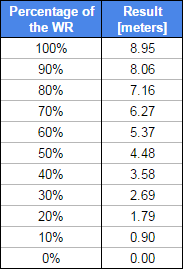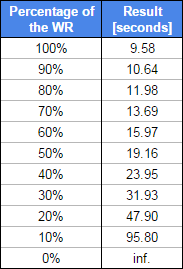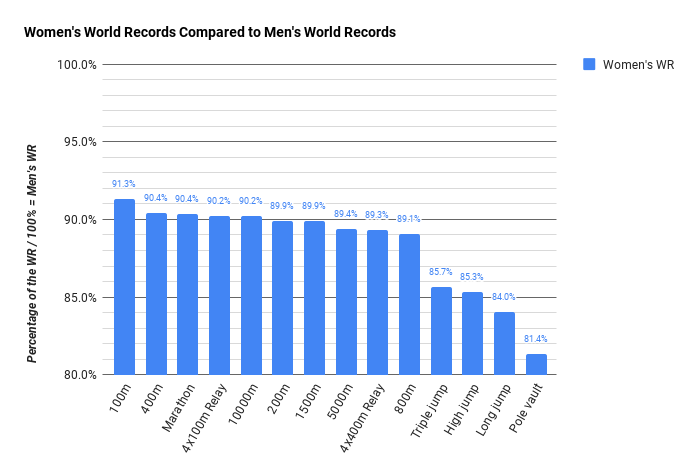Men’s world records are the pinnacle of what humans are capable of at any given point in time at a certain event or discipline, and I’ve always wondered about which of the women’s world records is the best when compared to men’s results.
For example, women’s 100m and 200m world records are 10.49 and 21.34 seconds, respectively. The question I would pose is which of these two results comes closer to their male counterparts of 9.58 and 19.19 seconds? In other words, is 10.49 technically closer to 9.58, or is 21.34 closer to 19.19? In other words, which record is better?
You can jump straight to chapter 2 if you want to avoid all the nasty math behind my methods.
1) Methodology
I’ve thought about how one would go about comparing all the results from all the different events and I came up with the following method: Every men’s WR is given a percentage value of 100% because it represents the ceiling of what is currently humanly possible. If the women’s WR is, say, 10% lower, it is given a value of 90%.
The problem arises when we try to compare running and jumping events (*) because:
Running -> less is better,
i.e., a faster time and a lower numerical value is a better result,
Jumping -> more is better,
i.e., a higher/longer jump and a larger numerical value is a better result.
So, let’s say that I want to jump half (or 50%) the distance of the men’s long jump WR which stands at 8.95 meters. This means that we have to multiply the WR by 0.5:
8.95 meters * 0.5 = 4.48 meters
So I have to jump 4.48 meters if I want to jump 50% as far as 8.95 m of Mike Powell. Below is a complete table with increments of 10% to give you a better understanding of the underlying principle for the jumping events.

Full formula for jumping events:
[World Record Distance\Height] * [Percentage of WR] = Result
The higher the percentage, the closer the result is to the world record. We see that the lower (or the worse) the result, the closer we get to zero.
The same isn’t true for running events because it’s obvious that a lower result indicates a better time. This means that if I want to run half (or 50%) as fast as Usain Bolt’s 100m WR of 9.58 seconds, I have to divide his WR with 0.5 in order to get a proper result. If I’d multiply his WR, I’d get a faster time. Example:
9.58 seconds * 0.5 = 4.79 seconds WRONG (I’m not a cheetah)
9.58 seconds / 0.5 = 19.16 seconds CORRECT
This means that if my average speed was 50% as fast as Usain Bolt’s, I’d run the 100m in 19.16 seconds. Below is another complete table with increments of 10% to give you a better understanding of the underlying principle for the running events.

Full formula for running events:
( [Distance] / [Percentage of WR] ) / ( [Distance] / [World Record Time] ) =
= [World Record Time] / [Percentage of WR] = Result
The lower (or the worse) the result, the longer/slower the time. The closer we get to 0%, the closer we get to infinite time. This means that it would take you about 16 minutes to cover the 100m if you’d run 1% as fast as Bolt, 2 hr 40 min if you’d run 0.01% as fast and so on. I think you get the idea. Slower speed => longer time.
Example for Long jump world records:
Men’s WR: 8.95 meters
Women’s WR: 7.52 meters
Calculation:
7.52 meters / 8.95 meters = 0.8402 => 84.02%
This means that women’s long jump world record is 84.02% as long as the men’s WR. In other words, it is 15.98% shorter/inferior.
Example for 100m world records:
Men’s WR: 9.58 seconds
Women’s WR: 10.49 seconds
Calculation:
(100m/10.49s) / (100m/9.58s) = 9.58 / 10.49 = 0.91325 => 91.33%
This means that women’s 100m WR is 91.33% as fast as the men’s WR or 8.67% lower/inferior.
*We cannot directly compare results in the following events:
- All the throwing events: men use heavier apparatuses,
- Sprint hurdles: women run 100m and men run 110m with higher hurdles,
- 400m hurdles: men have higher hurdles,
- 3000m steeplechase: men have higher hurdles.
- Multi-events: Men have Decathlon and women have Heptathlon with a different scoring system.
2) Comparing the World Records
Okay, this is what we’re here for. I chose to include only the most often contested Olympic events and not the special ones like the 300m or 600m which are very rarely seen in the senior ranks.
| Event | Men’s WR | Women’s WR | Percentage of the WR | Inferior by |
| 100m | 9.58 | 10.49 | 91.33% | 8.67% |
| 200m | 19.19 | 21.34 | 89.93% | 10.07% |
| 400m | 43.03 | 47.60 | 90.40% | 9.60% |
| 800m | 1:40.91 | 1.53.28 | 89.08% | 10.92% |
| 1500m | 3:26.00 | 3:49.11 | 89.54% | 10.46% |
| 5000m | 12:35.36 | 14:05.20 | 89.22% | 10.78% |
| 10000m | 26:11.00 | 29:01.03 | 90.23% | 9.77% |
| Marathon | 02:01:09 | 02:14:04 | 90.74% | 9.26% |
| 4x100m Relay | 36.84 | 40.82 | 90.25% | 9.75% |
| 4x400m Relay | 2:54.29 | 3:15.17 | 89.30% | 10.70% |
| Long jump | 8.95 | 7.52 | 84.02% | 15.98% |
| Triple jump | 18.29 | 15.67 | 85.68% | 14.32% |
| High jump | 2.45 | 2.09 | 85.31% | 14.69% |
| Pole vault | 6.22 | 5.06 | 81.61% | 18.65% |
In running events women’s world records are on average 90.02% as fast as the men’s world records and 84.09% as long/high in the jumping events.

We can see that the women’s 100m world record comes the closest to the men’s WR. This doesn’t surprise me one bit as I’ve already written about the high probability of 10.49 being a strongly wind-assisted run and I still firmly believe that women’s WR should stand at 10.61 seconds, which would equate to being 90.29% as fast as the men’s WR of 9.58. Alternatively, 10.49 was 94.7% (!) as fast as the men’s world record from that period (9.93), which is absolutely insane.
Anyway, you can interpret the results in many different ways, but one thing is still obvious: women seem to be much weaker jumpers than what we’d expect from their running world records. All the running events are very close to each other when compared to the men’s results and within a range of just 2.3% from best to worst. Jumping events are a totally different thing. The results are (relatively speaking) vastly inferior and I can’t really come up with any logical reasons as to why. If you have any ideas or explanations of your own, feel free to comment below.
Žiga P. Škraba
My roommate says your conclusions are your opinions not based upon the facts. I say these records are the facts!
LikeLiked by 1 person
I know this is old and all, sorry. But wouldn’t a reasonable explanation be that jumping is one of the shortest sports in existence (time-wise).
The typical difference stated regarding physiology is muscle power and energy supply to limbs, which is really important in sports with high acceleration but becomes less important on endurance (although it still matters).
Anyway, jumping is something that lasts just a couple of seconds, and high power delivery is a must. A bit like how internal combustion cars have now been dusted on every acceleration battle with Teslas.
LikeLiked by 1 person
Of course! Keep in mind that I was mostly just trying to present the data, not necessarily provide a reasonable interpretation. Your thoughts definitely make sense though.
LikeLiked by 1 person
From your analysis we learn that the female body at max performance achieves about 90% of the result in comparison of men on speed/endurance. I don’t know the difference for pure strength but looking at weightlifting wr’s it suggest the difference is even bigger. Now take an event like jumping which is a combination. Mainly speed is required but also an energy burst to push the bodyweight up. Meaning women suffer from two characteristics where men outperform them. Meaning the disadvantage is inflated/multiplied. Simple math to illustrate this
Endurance Male vs female = 100% vs 90%.
Jumping Male vs Female = 100%x100% vs 90%x90% = 100% vs 81%
These are made up numbers but the logic is solid. This effect is even more obvious when it comes to sports which are not heavily focused on a single task (i.e. athletics). For example games like soccer where a combination of strength, speed, agility etc is required. The difference in performance is hard to measure but feels much bigger then the 10% gap one would expect based o b the difference in Athletic events WR’s
LikeLiked by 1 person
Beyond the well know basic physiological differences between males and females (greater muscle mass, larger bone structure, which enhance short duration sports such as jumping) one must bear in mind that arguably every world athletic record where it is relevant has been made with the help of performance enhancing drugs. It’s possible that male physiology responds better to such substances and/or more effort and funding has been put into the male side of such programs because trainers know the numbers will be more impressive. It would be interesting to compare clean athletes numbers vs enhanced, see how the data works out.
LikeLike
Males respond better to performance enhancing drugs because men make testosterone, one of the ‘performance enhancing drugs’. That is the point. Men were created DIFFERENTLY than women. Men should not be allowed to claim they are female and compete against women. It is a HUGE injustice and disrespect to women, but that is where Progressive thinking (and following) has led…
LikeLike
We weren’t “created” differently, men and women evolved to have different roles because women have to grow and care for our offspring. Men had to go out and hunt for food, build shelter, and fight off predators or enemies while women were busy taking care of children. Thus, the weak men died and the strong men survived to pass on their genetics, and that’s how men evolved to have higher muscle mass, bone density, and the hormone profile to overcome physical challenges. Women will always be physiologically inferior due to the sacrifices humans made billions of years ago.
LikeLike
It could have to do with buoyancy. Women’s body is a little more buoyant (less dense) than men’s; this is most advantageous in endurance swimming. Could it have a small but noticeable effect in jumping too?
LikeLike
Watching Eugene22, thinking the best women sprinters are so impressive, (seems) like they could have been competitive with many male sprinters at the 84 Olympics. Am I crazy?
LikeLike
Yes, a bit crazy. Need to go back much further in time…maybe the 1920s? Jesse Owens ran 10.3 100 and 20.7 200 in the 1930s; hand times but also on a dirt track with inferior equipment and training. Women are not quite that level yet, but pretty close.
LikeLike